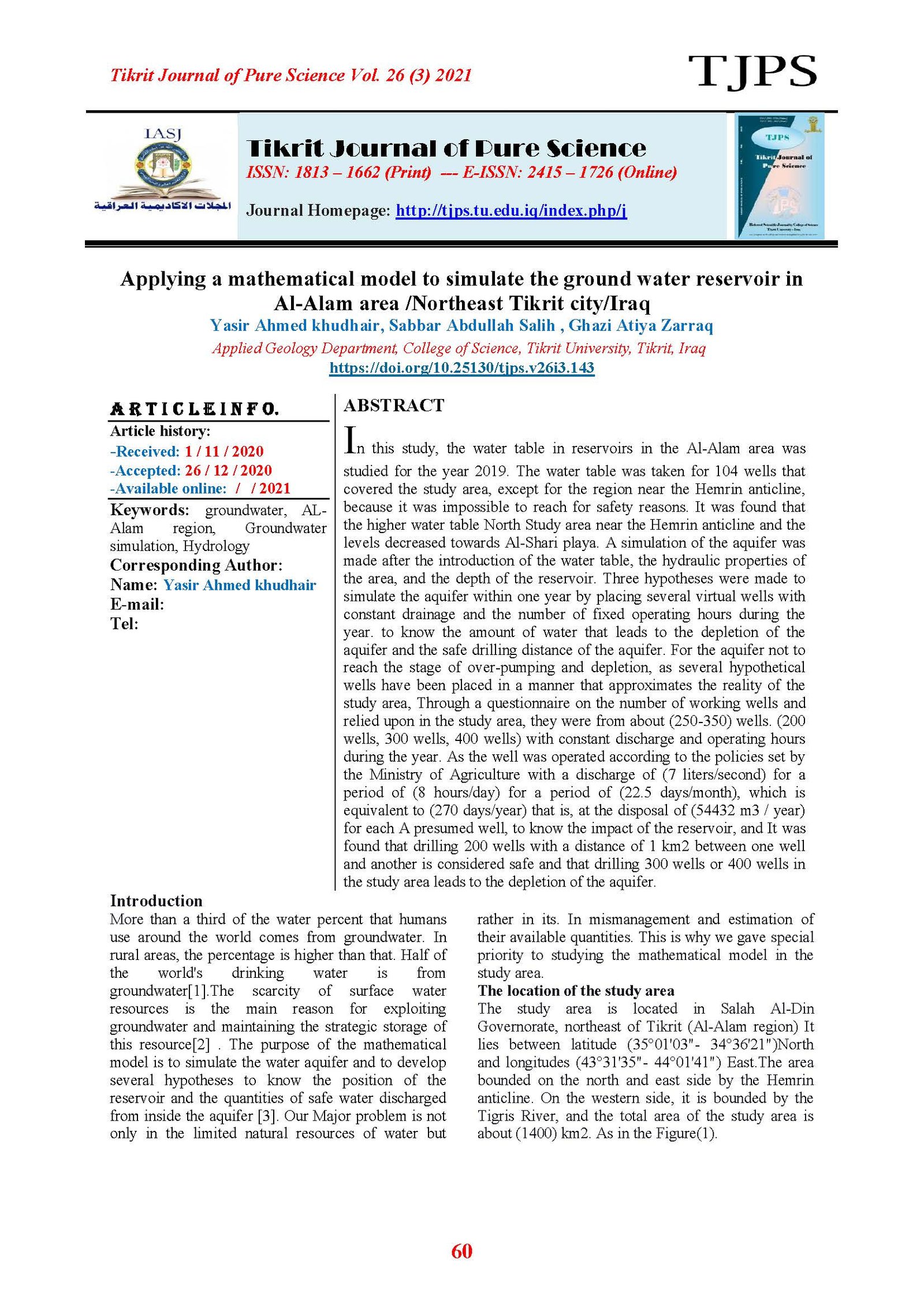Applying a mathematical model to simulate the ground water reservoir in Al-Alam area /Northeast Tikrit city/Iraq
Main Article Content
Abstract
In this study, the water table in reservoirs in the Al-Alam area was studied for the year 2019. The water table was taken for 104 wells that covered the study area, except for the region near the Hemrin anticline, because it was impossible to reach for safety reasons. It was found that the higher water table North Study area near the Hemrin anticline and the levels decreased towards Al-Shari playa. A simulation of the aquifer was made after the introduction of the water table, the hydraulic properties of the area, and the depth of the reservoir. Three hypotheses were made to simulate the aquifer within one year by placing several virtual wells with constant drainage and the number of fixed operating hours during the year. to know the amount of water that leads to the depletion of the aquifer and the safe drilling distance of the aquifer. For the aquifer not to reach the stage of over-pumping and depletion, as several hypothetical wells have been placed in a manner that approximates the reality of the study area, Through a questionnaire on the number of working wells and relied upon in the study area, they were from about (250-350) wells. (200 wells, 300 wells, 400 wells) with constant discharge and operating hours during the year. As the well was operated according to the policies set by the Ministry of Agriculture with a discharge of (7 liters/second) for a period of (8 hours/day) for a period of (22.5 days/month), which is equivalent to (270 days/year) that is, at the disposal of (54432 m3 / year) for each A presumed well, to know the impact of the reservoir, and It was found that drilling 200 wells with a distance of 1 km2 between one well and another is considered safe and that drilling 300 wells or 400 wells in the study area leads to the depletion of the aquifer.
Article Details

This work is licensed under a Creative Commons Attribution 4.0 International License.
Tikrit Journal of Pure Science is licensed under the Creative Commons Attribution 4.0 International License, which allows users to copy, create extracts, abstracts, and new works from the article, alter and revise the article, and make commercial use of the article (including reuse and/or resale of the article by commercial entities), provided the user gives appropriate credit (with a link to the formal publication through the relevant DOI), provides a link to the license, indicates if changes were made, and the licensor is not represented as endorsing the use made of the work. The authors hold the copyright for their published work on the Tikrit J. Pure Sci. website, while Tikrit J. Pure Sci. is responsible for appreciate citation of their work, which is released under CC-BY-4.0, enabling the unrestricted use, distribution, and reproduction of an article in any medium, provided that the original work is properly cited.
References
[1] Harter T (2015) Basic concepts of groundwater hydrology. ANRPublication 8083, FWQP Reference Sheet 11.1،University ofCalifornia
[2] Al-Sudani HIZ (2017) Hydrogeological study of Khan Al-Baghdadi area in Anbar Governorate—West of Iraq. Diyala J Pure Sci13(2):192–207.
[3] Al-Fatlawi, A.N., (2010):Hydrogeological Study for Ummerradhuma Aquifer - West of Iraq, M.S.C. thesis, univ. of Baghdad (unpubl), 162 P.
[4] GEOSURV.(2017). Evaluation of groundwater in the area between Tigris and Diyala rivers, Report, No. 3646.
[5] Jassim, S.Z., and Goff, J.C., 2006. Geology of Iraq, Published bu Dolin, prague and Musem, Brno Czech Republic, 2006, 337p.
[6] Delleur, J. W, (2007). The hand book of GROUNDWATER ENGINEERING.
[7] McCarthy, J.M. and Yeh, W.G., (1990): Optimal Pumping Test Design for Parameter Estimation and Prediction in Groundwater Hydrology. Water Reso, Rese, Vol. 26, No.4, PP. 779-791.
[8] Bear, J. and Verruijt, A., (1989): Modeling Groundwater Flow and Pollution. Theory and Application of Transport in Porous Media, D. Reider Pub. Go., Holland , 414 P.
[9] Ra’i, Kinan Jamal, (2015): A mathematical model to simulate the hydrogeological conditions of water carriers in the area between the North Kabir and the Pine rivers and assess their available resources, Department of Geology, College of Science, Tishreen University, PhD thesis (unpublished), 182 p.(In Arabic).
[10] Wang, J.F. and Anderson, M.P. (1982) (reprinted, 1995): Introduction to Groundwater Modeling, Academic Press, San Diego, CA. 237p .
